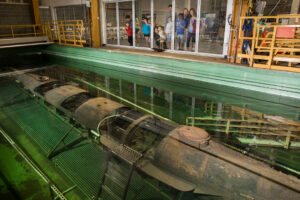For more information contact: For Immediate Release:
Kellen Correia at 843.743.4865, x.32 June 15th, 2011
The world’s first successful combat submarine was gently raised again today, but this time by only a few feet. In a nerve-racking moment for the Hunley team, the estimated ten-ton, forty-foot submarine was suspended into mid-air in her conservation tank. The raising kicks-off the project to move the Hunley to an upright position, a dangerous yet necessary step to save the submarine. The rotation will expose a side of the Hunley that has not been seen by anyone since her last crew boarded the vessel in 1864. Archaeologists are eager for the opportunity to study this new area, which may hold clues as to why the Hunley was lost.
With the submarine now resting safely at a 3-foot elevation, the clock is ticking for the Hunley team to complete the rotation project. The Hunley’s new position will not allow her to be completely submerged in the water that normally protects the artifact from corroding in the open air. Scientists will be working quickly to get the Hunley rotated and back into her protective water bath.
The lifting required the upmost precision as two cranes operated simultaneously with no room for error. Scientists took every precaution and weren’t too worried since Cecil Douglas with Parker Rigging Company was serving as crane operator. Cecil’s done this before. He put the Hunley into her conservation tank on August 8th, 2000, the historic day the submarine was lifted from the ocean floor after being lost at sea for over a century. “Now I can say I’ve lowered and raised the Hunley. Once the submarine is conserved, I plan to be there to lend a helping hand to help take the Hunley out of here and move her to a museum,” Cecil said.
The rotation of the Hunley will usher in the final phases of the project. Once she is upright, the concretion–a layer of shell, sediment, and rust–covering the Hunley will be removed, exposing the actual surface of the submarine. From there, scientists will be able to begin a comprehensive conservation treatment designed to ensure the Hunley survives for the benefit of future generations.
The Hunley Project
On the evening of February 17, 1864, the H. L. Hunley became the world’s first successful combat submarine by sinking the USS Housatonic. After signaling to shore that the mission had been accomplished, the submarine and her crew of eight mysteriously vanished. Lost at sea for over a century, the Hunley was located in 1995 by Clive Cussler’s National Underwater and Marine Agency (NUMA). The innovative hand-cranked vessel was raised in 2000 and delivered to the Warren Lasch Conservation Center, where an international team of scientists are at work to conserve the submarine for future generations and piece together clues to solve the mystery of her disappearance. The Hunley Project is conducted through a partnership with the Clemson University Restoration Institute, South Carolina Hunley Commission, Naval Historical Center, and Friends of the Hunley.



